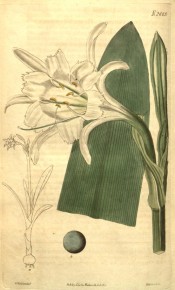Ismene narcissiflora (Jacq.) M.Roem.
The strap-like basal leaves sheath at the base to form a false stem, the flowering stems bearing umbels of up to 6 strongly scented white flowers, sometimes striped green. To 60cm. [RHSE, Hortus, Baker Am.].
Horticultural & Botanical History
First botanically described by Jacquin as Pancratium narcissiflorum in 1807 [Jacquin p.68/1807]. Placed in Ismene by Max Roemer in 1847 [Fam. Nat. Syn. Monogr. vol.4, p.186/1847].
Introduced to Britain in 1800. [JD]. ‘The genus Ismene is distinguished from Hymenocallis and Pancratium by a curved tube, and round green seeds, and from Hymenocallis by its short conniving filaments, of which the upper three dip into the cup. […] The species of Ismene are, 1. Amancaes; 2. calathina; 3. nutans; which last is figured in this work, No. 1561, unde the name of P. calathinum, which was afterwards corrected. The genus Ismene requires complete rest and drought in the winter; it thrives in the greenhouse, if not started too early in the season, better than in the stove. [William Herbert in BM t.2685/1826]. FS f.440/1849.
History at Camden Park
Listed in the 1845, 1850 and 1857 catalogues [B.266/1845].
Notes
Published May 17, 2009 - 01:03 PM | Last updated Jul 16, 2012 - 12:18 PM
| Family | Amaryllidaceae |
|---|---|
| Category | |
| Region of origin | Peru |
| Synonyms |
|
| Common Name | Peruvian daffodil |
| Name in the Camden Park Record | Ismene calathina
|
| Confidence level | high |
